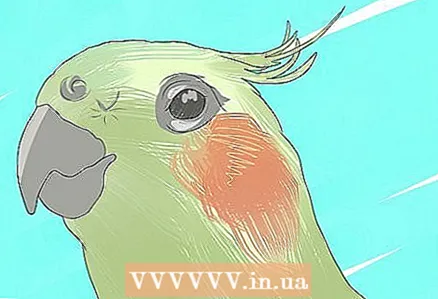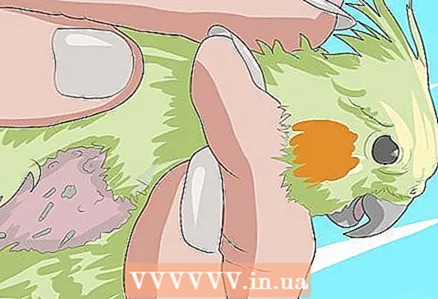Author:
Mark Sanchez
Date Of Creation:
4 January 2021
Update Date:
27 June 2024

Content
- Steps
- Method 1 of 3: Buying Equipment
- Method 2 of 3: Acquiring and training a cockatiel
- Method 3 of 3: Caring for your cockatiel
- Tips
- Warnings
Cockatiels are one of the smallest members of the parrot family, which for many people become loving and intelligent pets. Cockatiels are social birds that will imitate your voice and happily sit on your finger or shoulder. In this article, we'll show you how to take care of a cockatiel to keep your bird happy and healthy!
Steps
Method 1 of 3: Buying Equipment
 1 Consider if the cockatiel is the right pet for you. Corellas require daily care and attention, they can be noisy pets and litter a lot. With due care, they can live for over 20 years! Before purchasing a cockatiel, you should consider the following questions (it is advisable to do this with your household):
1 Consider if the cockatiel is the right pet for you. Corellas require daily care and attention, they can be noisy pets and litter a lot. With due care, they can live for over 20 years! Before purchasing a cockatiel, you should consider the following questions (it is advisable to do this with your household): - How much money are you willing to spend? While the cockatiels themselves are not very expensive, they require large cages, a lot of toys and other items. In addition, once a year, the cockatiel should be taken to the veterinarian.
- How much time are you willing to devote to the cockatiel? Unless someone is at home for most of the day, the Corella will be lonely alone. A couple of cockatiels require less attention, but you still have to devote time to them and take care of them daily.
- How sensitive are you to noise and confusion? Although not extremely noisy, cockatiels showcase their vocals in the mornings and evenings and can also be the source of a lot of confusion. If you are an advocate of cleanliness or hate waking up early in the morning, most likely, Corella will not work for you.
- How long are you willing to take care of your pet? Since cockatiels can live more than 20 years, carefully consider whether you can devote the right amount of time to her. If you are a minor, consider someone who will take care of the cockatiel while you are in class.
 2 Purchase a cage. The cage should be at least 60 cm high, 50 cm wide and 45 cm deep, but a larger cage is recommended. The rods of the cage in the lattice should be no further than 1.9 cm from each other. The use of stainless steel cages is recommended. Since zinc and lead are poisonous to birds, they must be guaranteed to be absent in the materials of the cage. Also, since cockatiels like to climb, there should be at least a few horizontal rods in the cage.
2 Purchase a cage. The cage should be at least 60 cm high, 50 cm wide and 45 cm deep, but a larger cage is recommended. The rods of the cage in the lattice should be no further than 1.9 cm from each other. The use of stainless steel cages is recommended. Since zinc and lead are poisonous to birds, they must be guaranteed to be absent in the materials of the cage. Also, since cockatiels like to climb, there should be at least a few horizontal rods in the cage.  3 Purchase the rest of the required inventory. Corellas, like other poultry, require certain things to be entertained. You will need to purchase:
3 Purchase the rest of the required inventory. Corellas, like other poultry, require certain things to be entertained. You will need to purchase: - Two feeders and one drinker. The bird will need two separate feeders for wet and dry food (wet food includes fruit, cooked beans, and so on).
- Screen for the cage, so that the grain does not scatter.
- Lots of perches. Cockatiels love to climb and play, so having lots of perches will make them happy. You will notice that the cockatiel will choose one of the perches as its home (where it will sleep).
- Various toys for the entertainment of the cockatiel. Get a few toys and change them every week to avoid annoying the bird. Cockatiels love to gnaw on something, so toys like twig balls, raffia strips, or palm trees work best.
 4 Purchase additional inventory (optional). While not necessary, it is a good idea to get a litter cleaning kit and a portable vacuum cleaner. In addition, it is advisable to purchase chalk stone as a source of calcium, which is especially important for females who may have problems laying eggs (females may lay unfertilized eggs without a male).
4 Purchase additional inventory (optional). While not necessary, it is a good idea to get a litter cleaning kit and a portable vacuum cleaner. In addition, it is advisable to purchase chalk stone as a source of calcium, which is especially important for females who may have problems laying eggs (females may lay unfertilized eggs without a male).
Method 2 of 3: Acquiring and training a cockatiel
 1 Learn more about cockatiels. Before purchasing a cockatiel, you should carefully study the information about these birds and how to care for them.While this article describes the basics of grooming, we recommend that you gain more in-depth knowledge. Good sources of information include the Internet, libraries, pet stores, where you can find books and other information on caring for cockatiels. In addition to talking with cockatiel owners about their experience in caring for birds, direct interaction with cockatiels is also recommended.
1 Learn more about cockatiels. Before purchasing a cockatiel, you should carefully study the information about these birds and how to care for them.While this article describes the basics of grooming, we recommend that you gain more in-depth knowledge. Good sources of information include the Internet, libraries, pet stores, where you can find books and other information on caring for cockatiels. In addition to talking with cockatiel owners about their experience in caring for birds, direct interaction with cockatiels is also recommended.  2 Get a cockatiel. You may be tempted to get the cheapest cockatiel you can find, but we don't recommend buying a cockatiel from a pet store. Birds from the pet store can be unhealthy and often not socialized (which makes taming difficult). You can purchase hand-fed chicks from a specialist poultry store or bird breeder. Buy cockatiels when they are three months old or slightly older. If you are a beginner, do not feed the chick by hand.
2 Get a cockatiel. You may be tempted to get the cheapest cockatiel you can find, but we don't recommend buying a cockatiel from a pet store. Birds from the pet store can be unhealthy and often not socialized (which makes taming difficult). You can purchase hand-fed chicks from a specialist poultry store or bird breeder. Buy cockatiels when they are three months old or slightly older. If you are a beginner, do not feed the chick by hand. - Purchase a cockatiel from the shelter. Before buying a pet, it's best to first try taking a shelter bird. While many of the shelter's pets can be wonderful, beginners are not advised to take birds from there, as they may become sick or have behavioral problems.
- Buy a cockatiel from a previous owner. Sometimes circumstances develop in such a way that the owners have to part with the pets. If the owner does not part with the bird because of behavioral problems and does not hide the bird's illnesses, this can be a great way to acquire a bird, especially for beginners.
 3 Tame the bird. If the cockatiel is already tame, you can skip this step and move on to the next. One of the main ingredients in taming a cockatiel is getting used to your constant presence. When you first bring your bird home, place the cage where there is a lot of human activity. Every day, sit next to the cage and talk to the bird, or whistle quietly for 10 minutes. This will help the bird get used to your voice and presence.
3 Tame the bird. If the cockatiel is already tame, you can skip this step and move on to the next. One of the main ingredients in taming a cockatiel is getting used to your constant presence. When you first bring your bird home, place the cage where there is a lot of human activity. Every day, sit next to the cage and talk to the bird, or whistle quietly for 10 minutes. This will help the bird get used to your voice and presence. - When the bird starts to get close to the side of the cage where you are, and at the same time feels completely comfortable with you, start giving her small treats (we will talk about what treats should be in the first step of the next section). Do this for about a week, and open the door in bulk and hold the treat in front of it, encouraging the bird to sit at the door. The next step is to place the treat in the palm of your hand so that the bird begins to eat from it.
 4 Train the bird to sit down. When you tame the cockatiel, that is, when she already eats from your hands, teach her to sit on your hand. The way in which this can be achieved depends on whether the bird bites. Do not try to grab the cockatiel or force it to sit on your arm, as this is more likely to result in a bite.
4 Train the bird to sit down. When you tame the cockatiel, that is, when she already eats from your hands, teach her to sit on your hand. The way in which this can be achieved depends on whether the bird bites. Do not try to grab the cockatiel or force it to sit on your arm, as this is more likely to result in a bite. - If your bird bites: Bring your finger quickly and smoothly to the top of the bird's feet, as if you were running your finger through a candle flame. The pet should automatically sit on your finger. Give the cockatiel a treat and compliment immediately afterward. If the bird begins to bite aggressively, discontinue the training session and try again later.
- If the cockatiel rarely bites, place your finger under the bird's belly in the leg area. Apply a little pressure and, more likely, it will immediately sit on your finger. When she does, immediately give her a treat and compliment. The next time you do this, while applying pressure, say, "Sit down." Eventually, the bird will begin to associate the action itself with the word.
Method 3 of 3: Caring for your cockatiel
 1 Give your bird time to get comfortable when you first bring it home. If it is a hand-reared chick, this time can be very short, up to several hours. Unsocialized birds, however, take 2-3 days to get used to their new environment.During the adaptation period, do not touch the bird, but feed it and clean the cage, and talk to it affectionately.
1 Give your bird time to get comfortable when you first bring it home. If it is a hand-reared chick, this time can be very short, up to several hours. Unsocialized birds, however, take 2-3 days to get used to their new environment.During the adaptation period, do not touch the bird, but feed it and clean the cage, and talk to it affectionately.  2 Provide your cockatiel with a healthy diet. Poultry pellets should make up 70% of the cockatiel feed. Grains can be a good treat, but don't overdo them as they are too fatty. Also, sometimes it is necessary to give Corella vegetables and fruits. Well-cooked beans and spaghetti are examples of delicious treats that can be given to cockatiels. When choosing fruits and vegetables, it is better to give preference to organic. Before giving vegetables and fruits to the bird, they must be thoroughly washed.
2 Provide your cockatiel with a healthy diet. Poultry pellets should make up 70% of the cockatiel feed. Grains can be a good treat, but don't overdo them as they are too fatty. Also, sometimes it is necessary to give Corella vegetables and fruits. Well-cooked beans and spaghetti are examples of delicious treats that can be given to cockatiels. When choosing fruits and vegetables, it is better to give preference to organic. Before giving vegetables and fruits to the bird, they must be thoroughly washed. - Not Feed the cockatiel avocado, chocolate, alcohol, onions, mushrooms, tomato leaves, caffeine, raw beans, as they are toxic. Very sweet or fatty foods, such as candy and sugary bars, are unhealthy for cockatiels.
- Remove leftover fresh food from the cage after four hours, as harmful bacteria can grow in them (and this will also create a mess).
 3 Make sure the cockatiel always has clean water. The water must be changed daily and replaced when food or feces has entered it. Give the bird water that you can drink yourself.
3 Make sure the cockatiel always has clean water. The water must be changed daily and replaced when food or feces has entered it. Give the bird water that you can drink yourself. - When cleaning the drinker, use hot water and a little soap. This will prevent the growth of fungi and disease in the bird.
 4 Give the cockatiel a caress. If your cockatiel is already tamed (or you have already tamed and trained it - we talked about this in the second part), you will need to spend at least an hour a day with the bird to keep it friendly and tame. Unless you've purchased bird diapers, interact with the bird in a towel-covered chair or in a room with an easy-to-clean floor.
4 Give the cockatiel a caress. If your cockatiel is already tamed (or you have already tamed and trained it - we talked about this in the second part), you will need to spend at least an hour a day with the bird to keep it friendly and tame. Unless you've purchased bird diapers, interact with the bird in a towel-covered chair or in a room with an easy-to-clean floor.  5 Understand why your cockatiel may bite. It is likely that you are offended and upset when the cockatiel bites you, but it is important to understand that the bird bites in a stressful situation, and not because it is trying to be mean. The bird bites, showing its fear and frustration - you do not need to take it personally. Think about what you were doing when the cockatiel bit you, try to look at the situation from her point of view. For example, a cockatiel can bite when someone tries to grab it or when a person is sloppy or rude to her. In addition, many cockatiels are protective of their cage and can be aggressive if you try to stick your hand into the cage.
5 Understand why your cockatiel may bite. It is likely that you are offended and upset when the cockatiel bites you, but it is important to understand that the bird bites in a stressful situation, and not because it is trying to be mean. The bird bites, showing its fear and frustration - you do not need to take it personally. Think about what you were doing when the cockatiel bit you, try to look at the situation from her point of view. For example, a cockatiel can bite when someone tries to grab it or when a person is sloppy or rude to her. In addition, many cockatiels are protective of their cage and can be aggressive if you try to stick your hand into the cage. - If the cockatiel bites outside the cage, put it back in the cage and wait until it calms down before removing it from there again.
- If the bird is aggressively guarding the cage, train it to perch. Thus, the cockatiel will sit on the perch when you need to get it, and you do not have to stick your hand into the cage.
 6 Teach the cockatiel to speak and whistle. While males are more amenable to training, a female can be taught to whistle and even a few words. First, teach the cockatiel to speak, and only then to whistle, otherwise it will be more difficult. To make Corella start talking, talk to her often, say the words that you want to hear from her often, for example, say: "Mommy!" - every time you approach the cockatiel. If you hear the beginning of a word or phrase, immediately reward the cockatiel with a treat and lots of attention.
6 Teach the cockatiel to speak and whistle. While males are more amenable to training, a female can be taught to whistle and even a few words. First, teach the cockatiel to speak, and only then to whistle, otherwise it will be more difficult. To make Corella start talking, talk to her often, say the words that you want to hear from her often, for example, say: "Mommy!" - every time you approach the cockatiel. If you hear the beginning of a word or phrase, immediately reward the cockatiel with a treat and lots of attention. - Teaching a cockatiel to whistle for the most part comes down to the same thing: often whistle in front of the cockatiel and reward it when it starts to whistle.
 7 Watch for signs of cockatiel disease. Since cockatiels often hide their ailments until it gets really bad, learn to clearly identify the signs of illness. A very sick cockatiel will sit with fluffy feathers at the bottom of the cage. Corella, who is bleeding, is obviously injured. Signs of avian disease may include:
7 Watch for signs of cockatiel disease. Since cockatiels often hide their ailments until it gets really bad, learn to clearly identify the signs of illness. A very sick cockatiel will sit with fluffy feathers at the bottom of the cage. Corella, who is bleeding, is obviously injured. Signs of avian disease may include: - Freakiness or biting, more than usual sleepiness, decreased weight and food intake, refusal to eat or water, cough, sneeze, irregular breathing, lameness, swelling, inflammation or crusting of the eyes or nostrils, cloudy eyes, dirty anus, lowering of the head, wings, tail.
 8 Have your bird regularly seen by your avian veterinarian. It is necessary to show the cockatiel to an ornithologist veterinarian, it is he who specializes in birds, every year.In addition, you should contact your veterinarian immediately if Corella exhibits any of the above signs of illness. Remember, although a visit to the vet can be expensive, birds get very sick in a short amount of time; in the case of cockatiels, you should not be guided by the principle of "wait and see", as they are quite gentle creatures.
8 Have your bird regularly seen by your avian veterinarian. It is necessary to show the cockatiel to an ornithologist veterinarian, it is he who specializes in birds, every year.In addition, you should contact your veterinarian immediately if Corella exhibits any of the above signs of illness. Remember, although a visit to the vet can be expensive, birds get very sick in a short amount of time; in the case of cockatiels, you should not be guided by the principle of "wait and see", as they are quite gentle creatures.  9 Remember that cockatiels can have nightmares. Some cockatiels are afraid of the dark and have "nightmares" when they frantically rush around the cage. To prevent this, turn on the night light where the cockatiel sleeps, and do not completely cover her cage at night.
9 Remember that cockatiels can have nightmares. Some cockatiels are afraid of the dark and have "nightmares" when they frantically rush around the cage. To prevent this, turn on the night light where the cockatiel sleeps, and do not completely cover her cage at night. - When you find out which perch your cockatiel prefers to sleep on, make sure that no toys are hanging nearby. If the bird has a nightmare, it can become entangled in the toy and seriously injure itself.
Tips
- Be careful with these little birds; cockatiels are very tender and easily hurt.
- Sing to the bird to get used to your voice.
- Don't even think about breeding birds if you don't know how to do it. You can harm them inadvertently.
- Corells love to have their heads scratched against the growth of feathers. It is good to caress the bird like this during molting, when it feels itching.
- Place the bird near the window (but not on the window). In no case should birds be kept in a basement or in a dark room. This can lead to depression or behavioral problems such as feather plucking.
- Corells require daily attention. If you work all day, consider purchasing a pair of cockatiels to keep each other company.
- There are many bird chat rooms and forums. Try to join one of them, there is a lot of information!
- To prevent accidents from flying into the fan, hot water in the kitchen, window glass, and so on, take care to clip the bird's wings. To do this, it is better to consult an experienced poultry breeder or ornithologist veterinarian.
- If you want a bird to communicate better with people, do not put it in the same cage with another bird. She will be more willing to communicate with a bird living with her.
- On very hot days, place ice cubes in the drinking bowl.
Warnings
- Do not include fan if the bird is outside the cage, as it can fall into the blades and die.
- Cockatiels love to play with mirrors and shiny objects. However, do not place the mirror in the cage towards them. They may view the reflection in the mirror as a different bird and become upset that it does not respond to them. A mirror is good for temporary entertainment, but if Corella stares into it all day, it will put her on the brink and drive her crazy.



